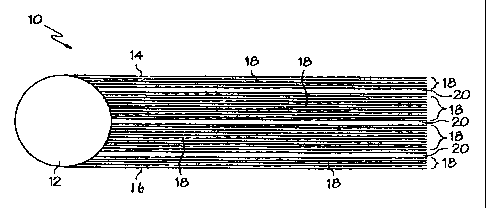Some of the information on this Web page has been provided by external sources. The Government of Canada is not responsible for the accuracy, reliability or currency of the information supplied by external sources. Users wishing to rely upon this information should consult directly with the source of the information. Content provided by external sources is not subject to official languages, privacy and accessibility requirements.
Any discrepancies in the text and image of the Claims and Abstract are due to differing posting times. Text of the Claims and Abstract are posted:
| (12) Patent: | (11) CA 2340877 |
|---|---|
| (54) English Title: | EXTENDED WIDTH NOTEBOOK SYSTEM |
| (54) French Title: | CARNET AVEC FEUILLES DE LARGEUR VARIABLE |
| Status: | Expired and beyond the Period of Reversal |
| (51) International Patent Classification (IPC): |
|
|---|---|
| (72) Inventors : |
|
| (73) Owners : |
|
| (71) Applicants : |
|
| (74) Agent: | SMART & BIGGAR LP |
| (74) Associate agent: | |
| (45) Issued: | 2006-10-03 |
| (22) Filed Date: | 2001-03-15 |
| (41) Open to Public Inspection: | 2001-09-15 |
| Examination requested: | 2001-03-15 |
| Availability of licence: | N/A |
| Dedicated to the Public: | N/A |
| (25) Language of filing: | English |
| Patent Cooperation Treaty (PCT): | No |
|---|
| (30) Application Priority Data: | ||||||
|---|---|---|---|---|---|---|
|
A notebook including a plurality of sheets, each sheet having a width, an
inner edge and a
tear guide line that extends generally parallel to and spaced apart from an
inner edge of the sheet.
The notebook further includes at least one divider pocket having a pocket
having a width
substantially equal to the width of the sheets. Each sheet can be torn along
its tear guide line to
produce a torn sheet having a width significantly less than the width of the
at least one pocket
such that a number of torn sheets can be received in the at least one pocket.
Note: Claims are shown in the official language in which they were submitted.
Note: Descriptions are shown in the official language in which they were submitted.

2024-08-01:As part of the Next Generation Patents (NGP) transition, the Canadian Patents Database (CPD) now contains a more detailed Event History, which replicates the Event Log of our new back-office solution.
Please note that "Inactive:" events refers to events no longer in use in our new back-office solution.
For a clearer understanding of the status of the application/patent presented on this page, the site Disclaimer , as well as the definitions for Patent , Event History , Maintenance Fee and Payment History should be consulted.
| Description | Date |
|---|---|
| Time Limit for Reversal Expired | 2010-03-15 |
| Letter Sent | 2009-03-16 |
| Grant by Issuance | 2006-10-03 |
| Inactive: Cover page published | 2006-10-02 |
| Inactive: Final fee received | 2006-07-17 |
| Pre-grant | 2006-07-17 |
| Notice of Allowance is Issued | 2006-05-23 |
| Letter Sent | 2006-05-23 |
| Notice of Allowance is Issued | 2006-05-23 |
| Inactive: IPC assigned | 2006-05-11 |
| Inactive: IPC assigned | 2006-05-11 |
| Inactive: Approved for allowance (AFA) | 2006-05-03 |
| Amendment Received - Voluntary Amendment | 2005-10-18 |
| Inactive: S.30(2) Rules - Examiner requisition | 2005-09-08 |
| Amendment Received - Voluntary Amendment | 2005-05-19 |
| Letter Sent | 2005-03-14 |
| Inactive: S.30(2) Rules - Examiner requisition | 2004-11-29 |
| Amendment Received - Voluntary Amendment | 2004-06-29 |
| Inactive: Office letter | 2004-02-04 |
| Inactive: S.30(2) Rules - Examiner requisition | 2003-12-29 |
| Inactive: S.29 Rules - Examiner requisition | 2003-12-29 |
| Application Published (Open to Public Inspection) | 2001-09-15 |
| Inactive: Cover page published | 2001-09-14 |
| Inactive: First IPC assigned | 2001-06-01 |
| Amendment Received - Voluntary Amendment | 2001-05-16 |
| Inactive: Filing certificate - RFE (English) | 2001-04-19 |
| Filing Requirements Determined Compliant | 2001-04-19 |
| Letter Sent | 2001-04-19 |
| Application Received - Regular National | 2001-04-17 |
| Request for Examination Requirements Determined Compliant | 2001-03-15 |
| All Requirements for Examination Determined Compliant | 2001-03-15 |
There is no abandonment history.
The last payment was received on 2006-02-21
Note : If the full payment has not been received on or before the date indicated, a further fee may be required which may be one of the following
Please refer to the CIPO Patent Fees web page to see all current fee amounts.
| Fee Type | Anniversary Year | Due Date | Paid Date |
|---|---|---|---|
| Application fee - standard | 2001-03-15 | ||
| Request for examination - standard | 2001-03-15 | ||
| Registration of a document | 2001-03-15 | ||
| MF (application, 2nd anniv.) - standard | 02 | 2003-03-17 | 2003-02-20 |
| Registration of a document | 2003-12-24 | ||
| MF (application, 3rd anniv.) - standard | 03 | 2004-03-15 | 2004-02-18 |
| MF (application, 4th anniv.) - standard | 04 | 2005-03-15 | 2005-02-18 |
| MF (application, 5th anniv.) - standard | 05 | 2006-03-15 | 2006-02-21 |
| Final fee - standard | 2006-07-17 | ||
| MF (patent, 6th anniv.) - standard | 2007-03-15 | 2007-02-19 | |
| MF (patent, 7th anniv.) - standard | 2008-03-17 | 2008-02-18 |
Note: Records showing the ownership history in alphabetical order.
| Current Owners on Record |
|---|
| MEADWESTVACO CORPORATION |
| Past Owners on Record |
|---|
| MARC L. MOOR |